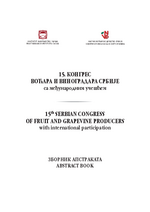Abstract: XV Serbian Congress of Fruit and Grapevine Growing (Kragujevac, Serbia): Updated information on the most promising apple cultivars and mutants
Guerra WalterResearch Center Laimburg, Pfatten, Laimburg 6, 39040 Auer, Italy
E-mail: [email protected]
Although there is a lot of excitement around the topic of new varieties the previews
show that even in 10 years the leading varieties in the apple world will be ‘Golden Delicious’,
‘Red Delicious’, ‘Gala’, ‘Fuji’, ‘Idared’, ‘Jonagold’, ‘Granny Smith’ and ‘Braeburn’.
Those varieties were discovered as chance seedlings or bred decades if not centuries
ago and they were introduced without a defined marketing strategy. While they
are free of royalties when it comes to fruit sells, some of their mutants are protected
by plant breeder’s rights and therefore they can’t be freely propagated.
The polyclonal variety group of ‘Gala’ is a classic example of a commodity where
clonal optimization is occurring. ‘Gala’ derives from a series of crosses between ‘Kidd’s
Orange’ and ‘Golden Delicious’ made by J.H. Kidd in New Zealand in the 1930ies later
on selected under the coordination of Don McEnzie. The first commercial orchards
were established in New Zealand in the 1960ies. Later on, mostly because of the discovery
of colour mutants – first of all ‘Royal Gala®’–‘Tenroy’ found by Bil ten Hove in
1973 in Matamata in New Zealand – ‘Gala’ has become a polyclonal variety and started
to be planted also in Europe, in the United States and in several countries of the
Southern hemisphere. In recent years we are facing both a further expansion of the
surface planted with ‘Gala’ but also a consistent substitution of old mutant orchards
which are not remunerative anymore with a new generation of better colouring ‘Gala’
mutants.
Moving from commodities and their clonal optimization to the development of new
cultivars, in the past decades a worldwide increase of apple breeding programs has
been noticed, with a raising share of breeding efforts financed by private organizations,
mostly nurseries or marketing organizations. From the objectives that breeders
are mainly looking for, two are most often mentioned: fruit quality and disease resistance.
The most studied resistance in apple is related to the fungus Venturia inaequalis. At
present there is a generation of scab resistant cultivars available which is carrying the
single Vf gene originated from Malus floribunda. These cultivars have reached the fruit
quality levels of the standard varietal assortment.
Many apple breeders are involved in tree habit studies. Their objective is to obtain
productive and regular cropping trees. While breeding for columnar types doesn’t appear
to be promising because of a strong linkage to poor fruit quality and biennial
bearing, the monocorimb character is strongly considered and promising. The general apple quality is characterized by four principal factors: appearance,
texture, flavour and nutritional properties. In case of appearance, considering that
already thousands of cultivars do already exist, there is not much space for innovation.
Homogeneity of the fruits in terms of appearance and size is and will be an important
characteristic for an agro industrial product like the apple. Modern apple varieties
require a minimum of firmness which should be as stable as possible in storage and
after shelf life. Furthermore there is no doubt that both juiciness and crispness are
important traits for the consumer. Breeding for special flavours like exotic or nutty
flavour is a big challenge since the heritability of those characteristics is not very well
known. For the new generations and the Asian markets breeding a super sweet apple
appears to have good chances for success. There is also an increasing demand for so
called children or snack apples, which are smaller in size and more convenient for the
comsumer. Regarding convenience, the objective of breeding seedless parthenocarpic
apples aims at increasing the ease of consumption of apples.
The nutraceutical value of apples can be improved by enhancing health-related
compounds, such as polyphenols. Within fruits, apples have a relatively high concentration
of polyphenols. Because of the high rate of consumption they are a major
source of polyphenols in the human diet. Breeding new cultivars is one way by which
polyphenol concentration is tried to be altered in apple fruits. One challenge in breeding
for high polyphenol content is that in many cases this trait is associated with bitter
or astringent taste. This is also the case for most of the known red fleshed cultivars,
where the breeders try to combine an innovative internal appearance with possible
health claims. The next generation of red fleshed cultivars is expected to be of higher
quality than the ones existing at the moment. The breeders who are looking for low
allergenic apples or apples for diabetics with high fructose content target a relatively
small, but consistent niche of consumers. Several institutes are involved in breeding
for fruit processing cultivars.
Documents

|
Abstract book 15th Serbian Congress of Fruit and Grapevine Growing () |
Links
|
15th SERBIAN CONGRESS OF FRUIT AND GRAPEVINE PRODUCERS with international participation |
Details
- Activity type
- Participation in scientific conference
- Activity work package
- Performance of new fruit varieties
- Activity number
- Laimburg-WP2-A72
- Activity contact
- Walter Guerra
Laimburg Research Centre
Laimburg 6 - Pfatten
I-39040 Post Auer (BZ), Italy
[email protected] - Activity partner
- Laimburg
- Activity country
- Italy
- Last edit
- 20-10-2017

The EUFRUIT thematic network has received funding from the
European Union's Horizon 2020 research and innovation programme
under grant agreement No 696337.
European Union's Horizon 2020 research and innovation programme
under grant agreement No 696337.